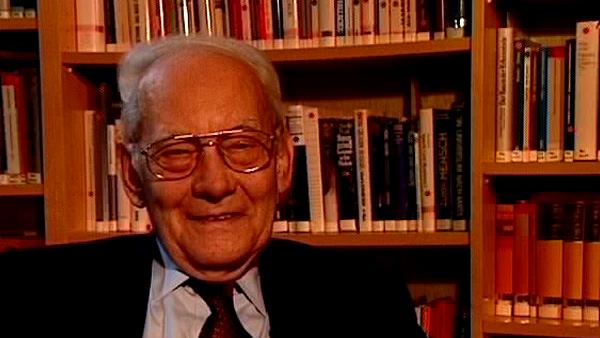NEXT STORY

The importance of understanding life at the molecular level
RELATED STORIES

NEXT STORY

The importance of understanding life at the molecular level
RELATED STORIES



I should perhaps explain what T-jump means. 'T' is for temperature, and temperature jump means we jump the temperature within a microsecond by 10 degrees centigrade, or anything you like. We do so by rapidly heating electrically the solution, and then we look with some optical method, either light absorption, or fluorescence, or polarimetry... so using polarised light.
[Q] That means that you have added a dye molecule, indicator, just to...
Well, if you study things like haemoglobin you have already a nice dye in there, but the same is true for many of the enzymes when you add certain material. So there is no difficulty at all and we will certainly later talk about those reactions when we go on.
[Q] And the T-jump were also those machines which were built and people could take along home to their own laboratories?
Yes.
[Q] The other more sophisticated machines just were available in the Bunsenstraße.
Yes.
[Q] Bunsenstraße was the old institute.
But by then we had about ten machines standing there, and we had many people in our laboratory who came for a longer or shorter visits, did some measurements with us and... that was the time of the '60s. You see, we went through several periods, and there were several waves of visitors. First the inorganic chemists, then of course with all the reactions of proteins, you have acid base catalysis, so we came into organic chemistry and then finally, once you are in organic chemistry you are not far from biochemistry, and as I said before the enzymes and the more complicated reaction networks were the best objects for such studies of what we call relaxation spectrometry.
Nobel Prize winning German biophysical chemist, Manfred Eigen (1927-2019), was best known for his work on fast chemical reactions and his development of ways to accurately measure these reactions down to the nearest billionth of a second. He published over 100 papers with topics ranging from hydrogen bridges of nucleic acids to the storage of information in the central nervous system.
Title: T-jump machines
Listeners: Ruthild Winkler-Oswatitch
Ruthild Winkler-Oswatitsch is the eldest daughter of the Austrian physicist Klaus Osatitsch, an internationally renowned expert in gas dynamics, and his wife Hedwig Oswatitsch-Klabinus. She was born in the German university town of Göttingen where her father worked at the Kaiser Wilhelm Institute of Aerodynamics under Ludwig Prandtl. After World War II she was educated in Stockholm, Sweden, where her father was then a research scientist and lecturer at the Royal Institute of Technology.
In 1961 Ruthild Winkler-Oswatitsch enrolled in Chemistry at the Technical University of Vienna where she received her PhD in 1969 with a dissertation on "Fast complex reactions of alkali ions with biological membrane carriers". The experimental work for her thesis was carried out at the Max Planck Institute for Physical Chemistry in Göttingen under Manfred Eigen.
From 1971 to the present Ruthild Winkler-Oswatitsch has been working as a research scientist at the Max Planck Institute in Göttingen in the Department of Chemical Kinetics which is headed by Manfred Eigen. Her interest was first focused on an application of relaxation techniques to the study of fast biological reactions. Thereafter, she engaged in theoretical studies on molecular evolution and developed game models for representing the underlying chemical proceses. Together with Manfred Eigen she wrote the widely noted book, "Laws of the Game" (Alfred A. Knopf Inc. 1981 and Princeton University Press, 1993). Her more recent studies were concerned with comparative sequence analysis of nucleic acids in order to find out the age of the genetic code and the time course of the early evolution of life. For the last decade she has been successfully establishing industrial applications in the field of evolutionary biotechnology.
Tags: T-jump, temperature, light absorption, fluorescence, polarimetry, polarised light, dye molecule, haemoglobin, complicated reaction networks, relaxation spectrometry, Bunsenstraße, T-jump machines, Max-Planck-Institut für Dynamik und Selbstorganisation
Duration: 2 minutes, 35 seconds
Date story recorded: July 1997
Date story went live: 24 January 2008